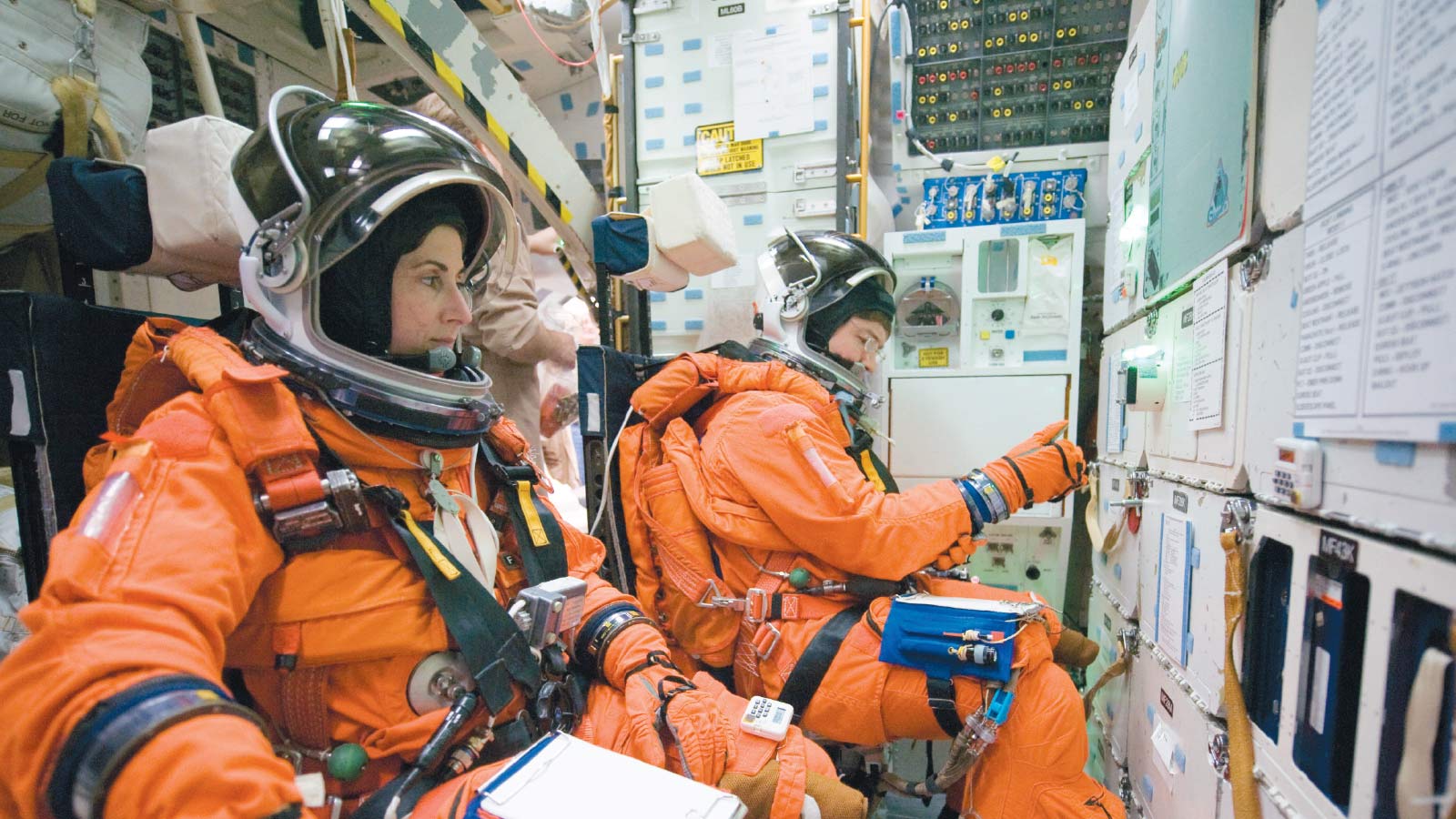
Such Great Heights
Summer 2016 | By Jeffrey Billman ’01
“The whole spaceflight experience…”
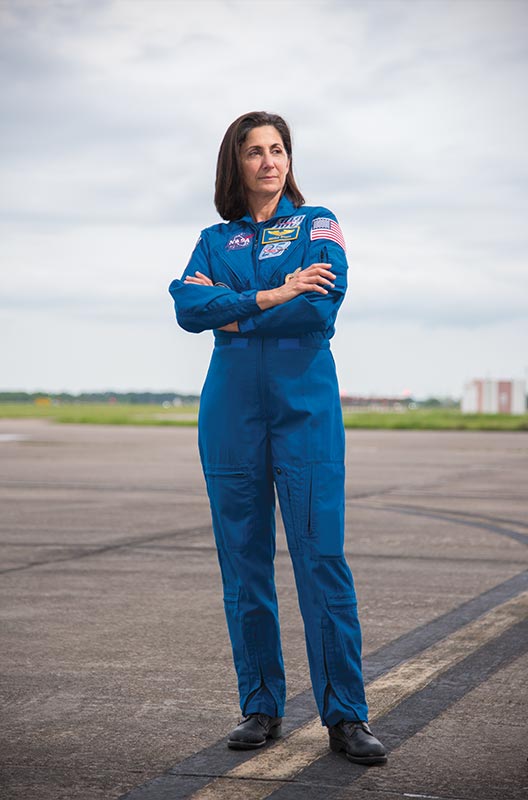
Her voice, which typically effuses confidence and energy but now sounds almost wistful, trails off, like she’s searching for the right word. And then she lands on it: “Surreal. I’m so thankful for the pictures and videos. They remind me I was really there.”
Nicole Stott ’92 has been on this planet for a little over 19,000 days — and off it for 104, in two space shuttles and a three-month stay on the International Space Station. She’s one of 533 people to enter Earth’s orbit and the 52nd woman to do so — and the 10th woman to perform a spacewalk.
Stott doesn’t dwell on her place in history. But the enormity of what she accomplished — the decades of preparation, the fearlessness of riding a rocket into the sky at more than 25,000 mph, and the six hours and 35 minutes spent in the vacuum of space, with only a bulky spacesuit and a thin white tether protecting her from the starlit abyss — stays with her.
But when she was in space, the surrealism wasn’t as daunting; the focus was on the specific, nitty-gritty objectives of each particular mission: fix this thing, check on that thing, make sure this other thing is running properly. Stott, like most astronauts, can talk for hours about the technical minutia that goes into keeping a football-field-size station operating while hurtling through space at 17,500 mph.
“You realize you’re not from Florida or the United States. You’re an earthling. The bottom line is we are all earthlings.”
Down here, those things feel impossibly complex. Up there, it’s the job you came to do — unglamorous but necessary. And so you focus on the task at hand. Then you come home and have time to reflect on what you’ve just experienced. “I’ll tell you, a spacewalk, that’s one of the times of my life where I felt the most alone and detached from any other human being,” Stott says. “But at the same time, I also felt the closest and most connected to humanity.”
She was alone in a literal sense, floating more than 200 miles above the Earth, far removed from life on terra firma. But from such great heights, you also see that indescribably beautiful blue marble, set against the blackest black, differently. The distinctions that drive so much conflict — race, class, religion and ideology — are no longer visible.
“You realize you’re not from Florida or the United States. You’re an earthling. The bottom line is we are all earthlings,” Stott says.
So last year, when Stott retired from NASA after 27 years, she decided that conveying this sense of awe and wonder was her new mission. And she does this with a brush and canvas, creating paintings that portray what it’s like to live and work in space and offer a sense of our place in the grand scope of the cosmos.
“I want people to look at [the paintings] and maybe think differently about where we live,” Stott says. “You can see Earth as your home, really looking at your home planet. People don’t consider it that way all the time. People don’t realize they’re in space.”
And if you think about it that way, she says, perhaps you’ll take better care of it.
Stott’s first-ever tweet was full of exclamation points. “On orbit! Feeling great! Launch was an incredible kick off the pad! Smiled the whole way! Got a ‘woo hoo’ in there for good measure!”
Her first flight, aboard Discovery STS-128 — STS-128, meaning the 128th space shuttle mission — blasted off from Kennedy Space Center at 11:59 p.m. on August 28, 2009. There were seven crew members; Stott was the only woman.
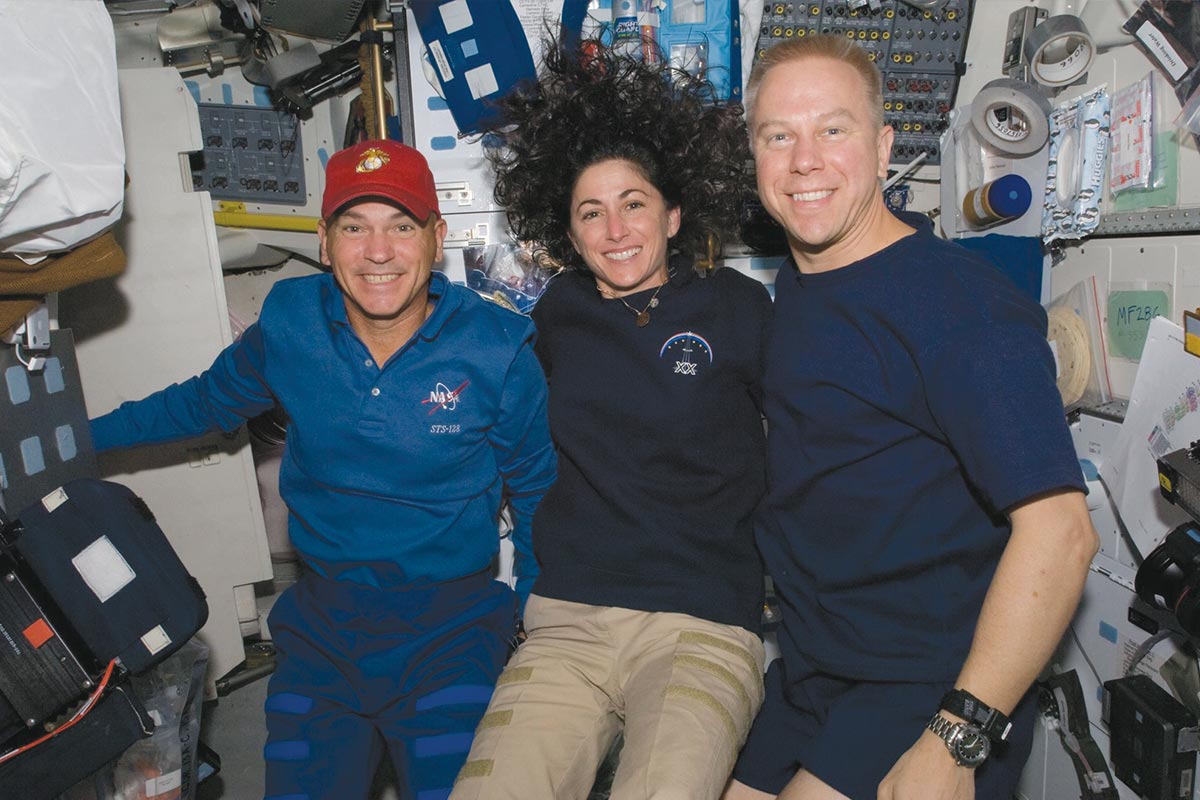
Stott and mission specialist Tim Kopra pose for a photo on Discovery while docked at the ISS.
While the astronaut class of 2013 had as many men as women, Stott’s class in 2000 had 14 males and only three females; all three were classified as mission specialists, not pilots. This wasn’t uncommon. As Amy Foster, a UCF associate professor of history who has studied women in space, points out, many of the pilots are drawn from the male-dominated Air Force. The women, on the other hand, tend to come up through the science and engineering fields, like Stott did. And — at least at the dawn of the 21st century — they stood out.
“They definitely get appreciation,” says Kevin Ford, a member of the 2000 astronaut class and the pilot of STS-128. “They had to come through a little tougher path to get there.”
Stott’s path began in Clearwater, Florida. Like most children of her generation, she watched the Apollo missions and the moon landing. She thought being an astronaut was cool, but it seemed far removed from her reality. Airplanes interested her more; her father flew them.
“I wanted my dad to show me not just how planes are built but how they fly,” she says. “The idea of flying into space evolved from a love of flying in general.”
She didn’t want to be a pilot, at least not as a vocation. She wanted instead to become an engineer. She earned her private pilot’s license and attended Embry-Riddle, earning a B.S. in aeronautical engineering in 1987.
“The only thing normal about every day is that every day is different.”
She soon got her first job with NASA, as an operations engineer at Kennedy Space Center (KSC). Over the next decade, she held a number of positions at KSC and went to grad school, earning a master’s degree in engineering management from UCF in 1992, which she says was “like the icing on the cake, preparing me for what I wanted to do with the astronaut office.” She started to realize that going into space didn’t seem so far-fetched.
So in 1998, she applied for the astronaut program. Two years later, she was accepted.
NASA officials told her class it would take about six years for them to get into space. In reality, it took nine as NASA assessed the loss of Columbia and its crew. In the meantime, Stott spent 18 days in 2006 living underwater as part of NASA’s Extreme Environment Mission Operations program, earning the title of aquanaut and claiming the women’s world record for saturation diving. But fly she did, as did all 17 members of her class. And like most of them, she went to space twice.
The first time, she spent three months on the International Space Station, where she performed maintenance tasks, did a spacewalk, assisted with research activities, and helped track and capture a Japanese cargo vehicle.
On the space station, Stott says, astronauts’ days are planned from the ground, sometimes down to 5- or 10-minute increments: when to wake up, when to eat, daily tasks, the occasional moment of free time and, finally, sleep.
As regimented as that sounds, Stott says, each day was a new adventure. “The only thing normal about every day is that every day is different.”
But one day was more different than the others: September 1, 2009, her spacewalk. Her prep for the spacewalk began the day before with a deliberate process to remove nitrogen from the body since, like divers, spacewalkers are at risk of getting the bends. Just before the walk came another elaborate process: getting suited up. After that, the airlock was completely depressurized, and the hatch opened. She was in the void.
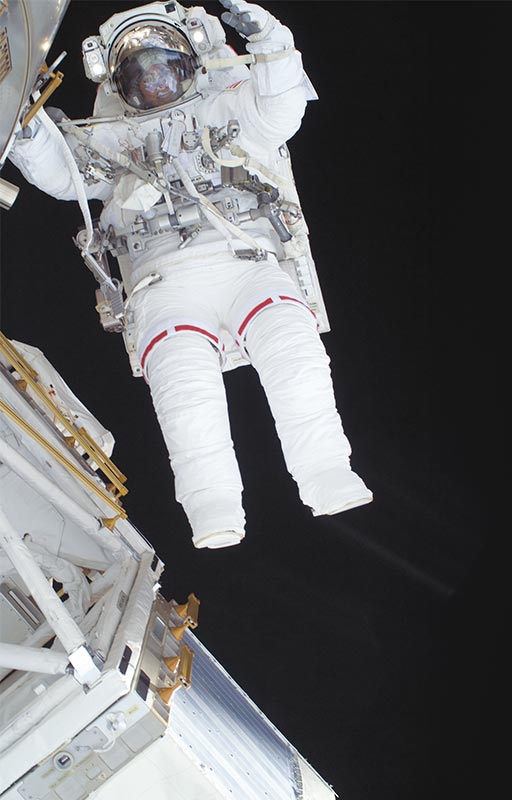
“I had spoken to a lot of people who had done spacewalks,” Stott says. “People have come out of the airlock and felt immediately disoriented. I was very pleased to not experience any of that.”
She and fellow spacewalker Danny Olivas had a couple of jobs that day. They had to remove a massive old ammonia tank and attach it to the station’s robotic arm. They also retrieved a technology experiment to be returned to Earth.
Stott rode on the robotic arm for 20 minutes, holding the bulky tank in her hands. “I felt like I was standing on the floor,” she says, “and everything else was moving around me.” It was very peaceful, almost Zen-like — I could nap here, she thought to herself. “You don’t want to do that,” she adds.
During her stay, Stott did two things that no one else had ever done. She was the first person to paint in space. And about halfway through her tenure, Stott co-hosted the first live NASA “tweetup” from the station, interacting with Twitter followers at NASA headquarters in Washington, D.C.
Stott had a knack for this sort of public relations, says Michael Barratt, who overlapped with Stott on the station for three weeks. She is “intense and really bright but also warm and affable. She could have been my long-lost sister, kidnapped by gypsies,” Barratt says.
While on the station, she and Barratt were tapped for another, higher-profile mission, one for which the space agency wanted to put its best foot forward — the final space shuttle flight. (As it turned out, this was not the last one, but STS-133, which Stott was on, was Discovery’s 39th and final mission.)
“We were looking for specific astronauts,” says Steven Lindsey, who commanded STS-133, “with superb technical capabilities but that could also represent NASA well. [Stott] was specifically chosen because we knew she could do that.”
“Everybody has members of a dream team,” Barratt says. “She was on a lot of people’s lists.”
Before she went into space, Stott remembers listening to the former Apollo astronauts, the guys who went to the moon, talk about seeing Earth from up there. The word she kept hearing was insignificant — as in, humanity and our little planet seem very small in this grandest scheme of things.
“That really bothered me,” she says. “How can ‘insignificant’ be the word?”
That wasn’t how she felt at all amidst the stars; she felt awed. Think about it: If the Earth was a little closer or farther from the sun, if the ionosphere and magnetosphere were not there to stave off solar flares, if the atmosphere wasn’t able to fend off X-rays and gamma rays, life here could never have emerged or evolved. None of what we know — our histories, our civilizations, our very consciousness — would exist.
We hit the cosmic jackpot.
One day on the space station, Stott says, she floated in front of a window and saw her home outside, so small and immense at the same time. “If we never find another one of us, that’s fine,” she thought. “It reinforces that we are significant; we were put in this perfect place for a reason.”
“When I’m 95, you can ask me if I want to go into space, and the answer will be yes, unequivocally yes.”
After her last mission, Stott led several different groups at NASA and was in line to fly again, but by 2015, she started to wonder if it wasn’t time to step aside, to tackle something new. She wanted to spend more time with her son, Roman, who is 13. “From a family standpoint,” she says, “it was the best decision I could have made.” That didn’t make it easy, however. “You have to be in a place where you’re moving on to another adventure — not that you’re running away from something.”
That new adventure was her art.
She’d painted before; in fact, she’d grown up doing artsy-craftsy things like woodworking and painting Christmas cards. Before her first journey to space, she decided she wanted to do something creative while there, so she brought a small watercolor kit.
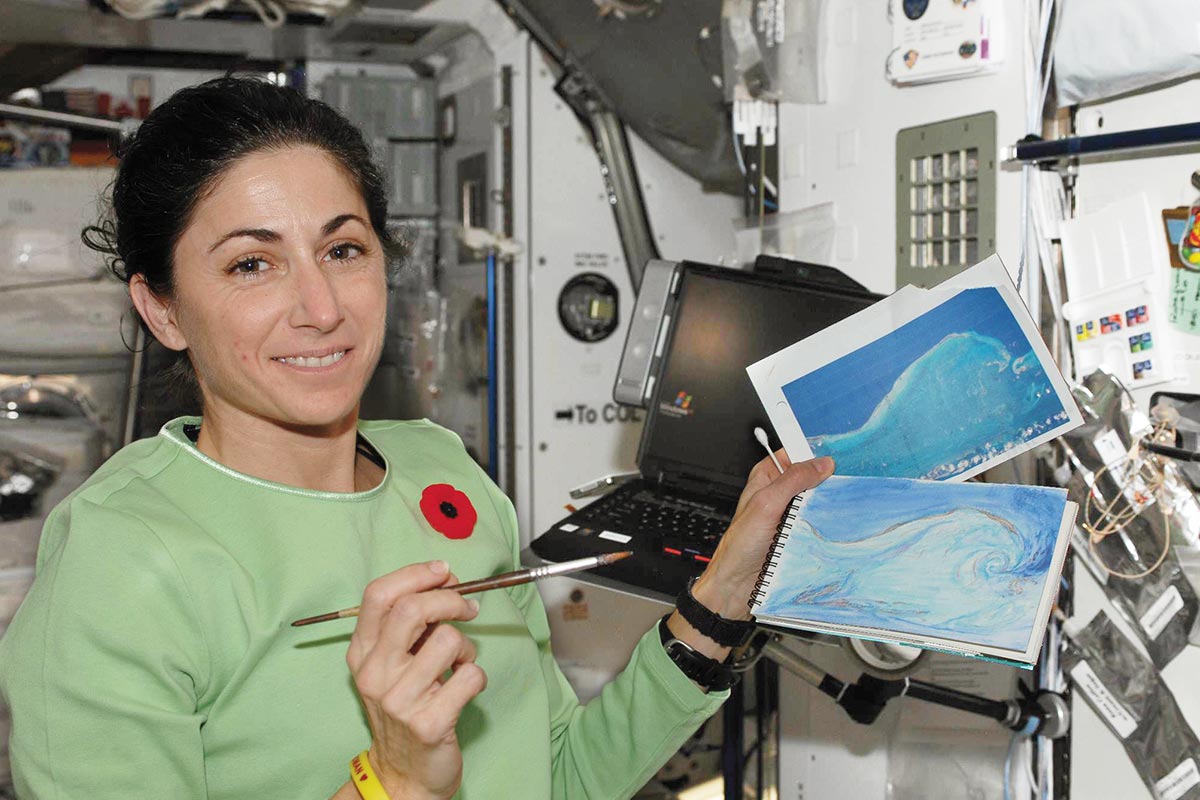
In 2009, Stott completed the first painting done in space. The Wave is based on a photo taken through the window of the ISS. She has since created a mixed media piece (right) based on the same photo of the Los Roques archipelago in Venezuela.
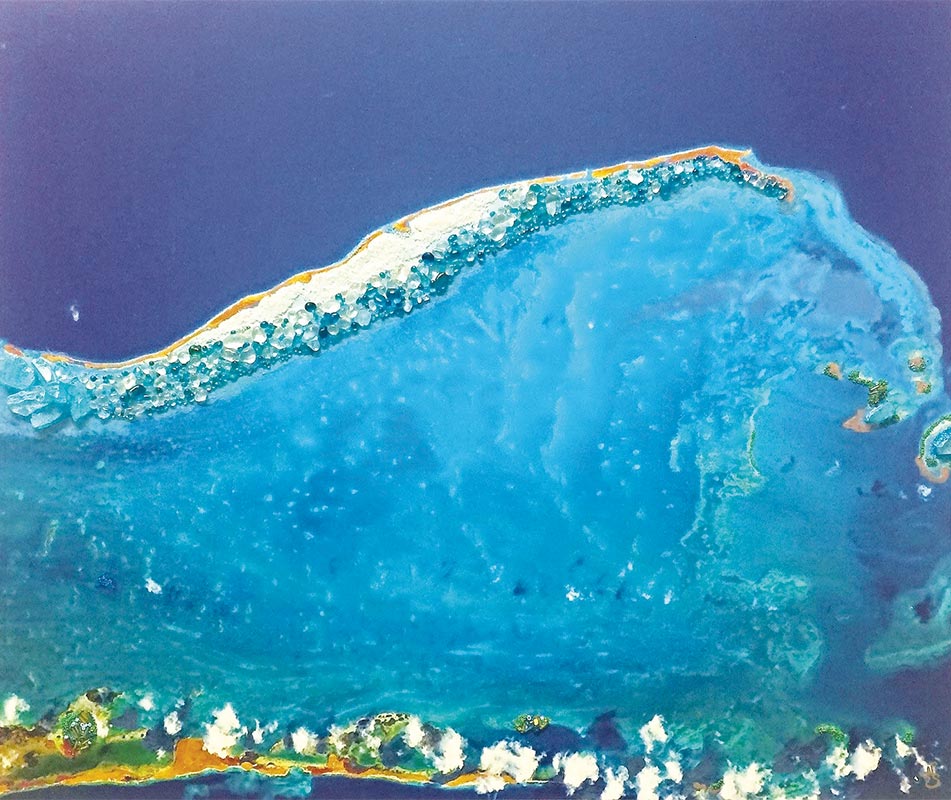
Her first painting in space — the first painting in space, made on the space station in 2009 — was a watercolor called The Wave, based on a picture she took from space of the Los Roques chain of islands, off the northern coast of Venezuela. To keep the paint from floating away, she dipped her brush into a drop of water before dipping it into the dry paint. The result was an image as seen from space, a thin stretch of green land jutting into a blue ocean.
“I wanted to find a way that would allow me to creatively express the experiences I’ve had,” she says.
She has two series of paintings. The first is what she calls the spacecraft collection, which captures life and work scenes from her space shuttle and space station flights. The other is a collection of paintings based on the photos she took from space — an effort to spread the message that “this is our planet, and we need to take care of it.”
In that vein, last year Stott was one of several astronauts who participated in a video message delivered to the diplomats gathered at the Paris climate conference, calling on them to act now to save the planet’s future.
And, as a speaker who visits schools all over the country, she also wants to inspire kids to do what she’s done in her second career: Blend art with science. The acronym is “STEAM,” a play on STEM (science, technology, engineering and math) with an “A” for “art” thrown in.
“There’s always been this need to keep the arts in play with the science and tech stuff,” she says. “Even the STEM people, if they really thought about it, they’d see that everything we do in engineering or in the lab, just being curious, is very artistic. The way we communicate math is very artistic, as is the imaging of astronomical data. It really all comes down to communication.”
Integrate art into STEM fields, she argues, and you’ll not only have more well-rounded students but more engaged students. “With STEAM,” she says, “we’re starting to realize that we need to think about education again in a more Renaissance kind of way.”
Similarly, she says, her time in space has made her fonder of science fiction. At its best, Stott says, sci-fi is a combination of artistry and science that tickles our imaginations and expands the boundaries of what we conceive as possible.
There’s another reason science fiction appeals to Stott: She hasn’t quite shed the space bug. “That desire to go into space will never go away,” she says. “When I’m 95, you can ask me if I want to go into space, and the answer will be yes, unequivocally yes.”
Jeffrey Billman ’01 ’10MA graduated from UCF with a B.A. in journalism and an M.A. in political science. He is currently the editor in chief of INDY Week in Raleigh-Durham, North Carolina.